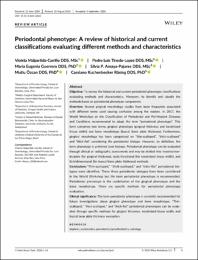Mostrar el registro sencillo del ítem
Periodontal phenotype: A review of historical and current classifications evaluating different methods and characteristics
| dc.contributor.author | Malpartida-Carrillo 1, Violeta | |
| dc.contributor.author | Tinedo-Lopez 1, Pedro Luis | |
| dc.contributor.author | Guerrero 2, Maria Eugenia | |
| dc.contributor.author | Amaya-Pajares 3, Silvia P. | |
| dc.contributor.author | Özcan 4, Mutlu | |
| dc.contributor.author | Kuchenbecker Rösing 5, Cassiano | |
| dc.date.accessioned | 2021-06-17T03:29:47Z | |
| dc.date.available | 2021-06-17T03:29:47Z | |
| dc.date.issued | 2021 | |
| dc.identifier.uri | https://hdl.handle.net/20.500.14308/3064 | |
| dc.description.abstract | Objective: To review the historical and current periodontal phenotype classifications evaluating methods and characteristics. Moreover, to identify and classify the methods based on periodontal phenotype components. Overview: Several gingival morphology studies have been frequently associated with different terms used causing confusion among the readers. In 2017, the World Workshop on the Classification of Periodontal and Peri-Implant Diseases and Conditions recommended to adopt the term “periodontal phenotype”. This term comprises two terms, gingival phenotype (gingival thickness and keratinized tissue width) and bone morphotype (buccal bone plate thickness). Furthermore, gingival morphology has been categorized on “thin-scalloped”, “thick-scalloped” and “thick-flat” considering the periodontal biotype. However, by definition, the term phenotype is preferred over biotype. Periodontal phenotype can be evaluated through clinical or radiographic assessments and may be divided into invasive/non invasive (for gingival thickness), static/functional (for keratinized tissue width), and bi/tridimensional (for buccal bone plate thickness) methods. Conclusions: “Thin-scalloped,” “thick-scalloped,” and “thick-flat” periodontal bio types were identified. These three periodontal biotypes have been considered in the World Workshop but the term periodontal phenotype is recommended. Periodontal phenotype is the combination of the gingival phenotype and the bone morphotype. There are specific methods for periodontal phenotype evaluation. Clinical significance: The term periodontal phenotype is currently recommended for future investigations about gingival phenotype and bone morphotype. “Thin scalloped,” “thick-scalloped,” and “thick-flat” periodontal phenotypes can be evalu ated through specific methods for gingival thickness, keratinized tissue width, and buccal bone plate thickness evaluation | es_PE |
| dc.format | application/pdf | es_PE |
| dc.language.iso | eng | es_PE |
| dc.publisher | Journal of Advances in Esthetic Dentistry 2021 | es_PE |
| dc.rights | info:eu-repo/semantics/openAccess | es_PE |
| dc.rights | Attribution-NonCommercial-NoDerivs 3.0 United States | * |
| dc.rights.uri | licenses/by-nc-nd/3.0/us/ | es_PE |
| dc.rights.uri | http://creativecommons.org/licenses/by-nc-nd/3.0/us/ | * |
| dc.source | Universidad Privada San Juan Bautista | es_PE |
| dc.source | Repositorio Institucional UPSJB | es_PE |
| dc.subject | implants | es_PE |
| dc.subject | periodontics | es_PE |
| dc.subject | periodontics/prosthodontics | es_PE |
| dc.subject | radiology | es_PE |
| dc.title | Periodontal phenotype: A review of historical and current classifications evaluating different methods and characteristics | es_PE |
| dc.type | info:eu-repo/semantics/article | es_PE |
| dc.publisher.country | PE |


